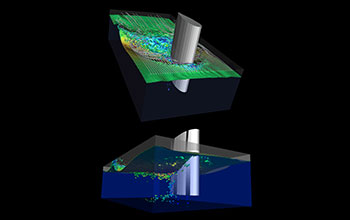Multimedia Gallery
Visualization Showing Water Flowing Past an Airfoil
Researchers at the Texas Advanced Computing Center (TACC) created this 3-D visualization that shows water flowing past an airfoil that approximates a ship's hull. The simulation of breaking waves, spray sheets and air entrainment plays a key role in the design and operation of naval combatants. As a ship progresses through water, steep, breaking waves are formed. Spray is shed along the crests of the breaking waves and also near the ship's bow, where thin sheets of water form. Air is also entrained along the turbulent face of breaking waves and along the contact line where the free surface, which is the interface between the air and water, intersects the hull. These phenomena are among the most challenging problems in computational fluid dynamics today.
TACC is supported by the National Science Foundation (NSF), The University of Texas at Austin, UT System, and grants from other federal agencies. As a leading resource provider in the NSF XSEDE (Extreme Science and Engineering Discovery Environment) project, TACC is one of 11 centers across the country providing leadership-class computing resources to the national research community. To learn more, visit the TACC website Here. (Date of Image: 2005)
Credit: Karla Vega, Texas Advanced Computing Center, The University of Texas at Austin; Doug G. Dommermuth, Science Applications International Corporation
Images and other media in the National Science Foundation Multimedia Gallery are available for use in print and electronic material by NSF employees, members of the media, university staff, teachers and the general public. All media in the gallery are intended for personal, educational and nonprofit/non-commercial use only.
Images credited to the National Science Foundation, a federal agency, are in the public domain. The images were created by employees of the United States Government as part of their official duties or prepared by contractors as "works for hire" for NSF. You may freely use NSF-credited images and, at your discretion, credit NSF with a "Courtesy: National Science Foundation" notation.
Additional information about general usage can be found in Conditions.
Also Available:
Download the high-resolution JPG version of the image. (10.6 MB)
Use your mouse to right-click (Mac users may need to Ctrl-click) the link above and choose the option that will save the file or target to your computer.



